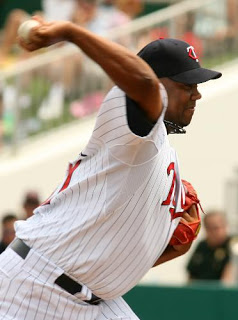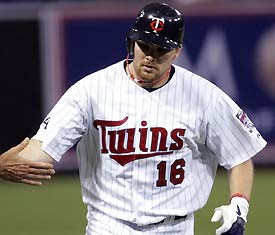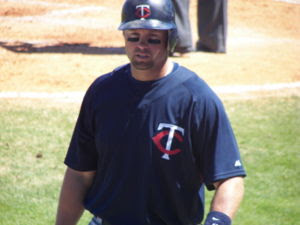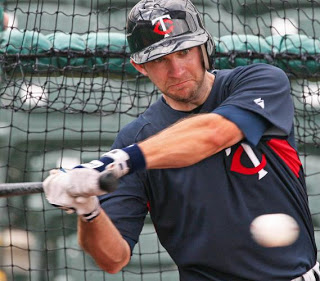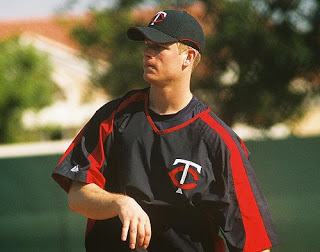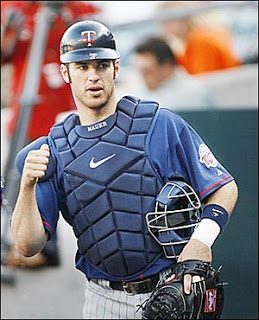It's been at least a few months since I mysteriously disappeared from this blog, except for having the title "slacker" bestowed upon me. Of course, Mr. Nelson has done a fine job of keeping things moving along on this blog while I've been trying to make it through my first year of law school. After completing a journal tryout this weekend (something, if you go to law school, I'm not sure I'd recommend), I am on spring break with a little time to try and write something up. Usually, during Spring Training, I write the National League preview for the season and I'd like to continue this year before I return to the grind.
NL West
Outside of the pathetic San Fransisco Giants, this actually should be the most competitive division in the National League.
1) Arizona Diamondbacks
As much as I love the Rockies, their young organization, and the amazing run that they had last year, it's kind of hard to pick against the Diamondbacks considering the move the made this offseason. As big as the Johan Santana trade was, the trade for Dan Haren has just as much potential for impact in the NL. By that I don't mean to imply that Haren is a better pitcher than Santana, but he is younger (27 to 29), cheaper, and is ready to combine with one of the best, if not the best, starters in the NL over the last five years -- Brandon Webb.
If you haven't been paying attention, Webb has had an ERA under 3.59, over 200 innings, and a K rate above 6.7 in each of the past four years and he had the amazing shutout innings run last year. In addition to the Webb-Haren tandem, the Diamondbacks also have Randy Johnson in the rotation. Johnson is 44, coming off major back surgery, and very close to retirement, but he showed in limited time last year that he can still be effective. With Doug Davis and Micah Owings finishing off the rotation, the Diamondbacks look pretty intimidating. While their offense isn't too potent, they are supported by up-and-coming stars like Justin Upton, Conor Jackson, Mark Reynolds, Stephen Drew, and Orlando Hudson. The bullpen is suspect (having traded Jose Valverde to the Astros), but two aces in the hole should have a positive effect on that.
2) Colorado Rockies
As you might be able to tell, I really like the Rockies and yes, I think they are for real. They have an impressive lineup that includes an MVP candidate in Matt Holiday (who hit .340/.405/.607 last year with 92 extra-base hits) and four above-average hitters in Todd Helton, Garrett Adkins, Brad Hawpe, and Troy Tulowitzski that can carry the team offensively (as evidenced by the .791 team OPS last year). Of course, most people point to a home-field advantage, which is understandable given the team's .298 average and .853 OPS at Coors versus a .730 OPS on the road. However, most of the best hitters outside of Tulowitzski performed adequately or above-average on the road anyway.
However, the most significant development that bodes well for the Rockies, outside of their outstanding team defensive play, is the development of a good, young pitching staff. In addition to Jeff Francis, the Rockies have solid middle-of-the-rotation guys like Aaron Cook as well as young up-and-comers like Ubaldo Jimenez, who had some memorable outings late in the year last year, and Baseball America's No. 8 ranked prospect Franklin Morales. They also have a good young closer in Manny Corpas and other potential solid starters like Taylor Buchholz (aren't you glad the Twins didn't trade for Jason Jennings?) who may survive the Rocky Mountain air.
3) Los Angeles Dodgers
Perhaps I'm being too hard on the Dodgers. After all, they have one of the best bullpens around (Takashi Saito, with a 1.77 ERA and a 185/36 K/BB ratio in 142 2/3 big league innings, and young flamethrowers Jonathan Meloan and Jonathan Broxton) as well as an impressive rotation lead by Chad Billingsley, Derek Lowe, and Brad Penny, with Jason Schmidt returning as well. The Dodgers also added 33-year-old Hiroki Kuroda from Japan, who is nearly impossible to project, as he could easily be the next Kei Igawa or the next Hideo Nomo. That staff had a 4.20 ERA last year. However, it isn't the pitching that is the most worrisome aspect of the Dodgers that will hold them back.
Even with a more competent manager in Joe Torre, the Dodgers do not possess enough firepower to get it done in the NL West. Yes, they have Jeff Kent, who somehow just keeps on hitting, as well as new addition Andruw Jones, James Loney and Russell Martin, one of the best-hitting catchers in the bigs. However, the Dodgers also have plenty of question marks. Juan Pierre is an overpaid one-tool player who will likely remain in the outfield, keeping bats from young stud Matt Kemp and the solid Andre Ethier. Despite the fact that potential star Andy LaRoche waits in the wings, the awfully mediocre Nomar Garciappara will keep sucking at-bats away at third. And shortstop Rafael Furcal is a big question mark after a sub par year last year in which he posted a .687 OPS and stole only 25 bases.
4) San Diego Padres
I predict a close and hard fought battle in the West and ultimately, I don't think that the Padres are up to the task to keep up with the Diamondbacks and Rockies. They have a very good 1-2 at the top of their rotation in Cy Young winner Jake Peavy and Chris Young, but the starting staff looks spotty to me after that. Greg Maddux can still eat innings, but he's a league average starter at this point with outstanding control keeping him in that realm. Outside of that, the rotation will likely be made up of two injury-prone pitchers (Randy Wolf and Mark Prior) and possibly a fringe-starter in Justin Germano. It's possible that Prior or Wolf, or maybe both, will have great comeback seasons, but I don't see it as likely and that hurts the Padres' chances of getting to the postseason. In limited time last year, Wolf didn't look very good (4.73 ERA, with Petco helping) and last time Prior pitched, he was a disaster (7.21 ERA in 43 innings in 2006).
Also, the Padres offense isn't terribly impressive. Outside of Adrian Gonzalez and possibly Kevin Kouzmanoff as young studs, the Pads have a shortstop with a sub-.300 OBP (Khalil Greene, who, in fairness, did show good power last year with 44 doubles and 27 homers) and two past-their-prime former stars in the outfield in Brian Giles and Jim Edmonds. In other words, too much would have to go right for this team to go to the postseason.
5) San Fransisco Giants
Outside of the awesome 1-2 punch of Matt Cain and Tim Lincecum, there is nothing to like about this team. Barry Zito is perhaps the most overpaid player in all of sports, as he can not even make it as a flyball pitcher in the cavernous A T & T Park. Noah Lowry is solid, but walks too many hitters and doesn't strike out enough to have lots of future success. There isn't much of a bullpen in the Bay to speak of. And the offense? Who is the star now that Barry is gone? Rich Aurilla (.252/.304/.368 last year)? Ray Durham (.218/.295/.343)? Omar Vizquel (.246/.305/.316)? I really feel for you, Giants fans.
NL Central
The NL Central is pretty clearly the weakest division in the NL and it is likely that only two teams will be competing for its title.
1) Milwaukee Brewers
The difference between the Cubs and the Brewers isn't all that great, but I'm giving it the Brewers simply because they have more young talent that can carry them into the playoffs. With a core of Prince Fielder, Rickie Weeks, J.J. Hardy, and Ryan Braun, the offense of the Brewers is pretty set for a few years. Specifically, Fielder and Braun were on fire last year, combining to hit .304 with 84 home runs, 216 RBI, and 200 runs. In other words, the offense will likely be the best in the NL Central.
There are questions about the rotation to be for sure. Ben Sheets is awfully talented, but he hasn't been truly healthy since 2004 and Jeff Suppan is nobody's idea of an ace. However, Yovani Gallardo is one of the better young pitchers in the game, having gone 9-5 with a 3.67 and 101 strikeouts in 110 1/3 innings last year. Also, starters Dave Bush and Chris Capuano are potential comeback candidates, as both took steps back last year. While Eric Gagne isn't the most sure-fire closer, there are as many if not more questions about the Cubs' bullpen.
2) Chicago Cubs
Out of all the NL Central teams, the Cubs are the only ones that made a big signing with some potential by giving Kosuke Fukudome a four-year, $48 million deal. That certainly improves their outfield but I am still not blown away by their offense. Alfonso Soriano was good last year, rattling off 80 extra-base hits, but he's on the wrong side of 30. Derrek Lee lost a lot of his power last year and at 32, that might be a permanent trend. (Though, in fairness, if he follows the Todd Helton path of plus .300 averages, lots of walks and doubles, no one should complain.) Outside of cockfighting lover Aramis Ramirez, the Cubs have a lot of young players and question marks filling out positions. Thus, it seems easier trust the younger talented Brewer offensive core over this aging core.
Pitching-wise, the Cubs have a very questionable bullpen, two good starters (Carlos Zambrano and Ted Lilly), and lots more question marks. Beyond Zambrano and Lilly, neither of which are true aces (for different reasons, as Zambrano walks far too many hitters and has seen negative trends the last few years, while Lilly is much more of a good number two), the Cubs are looking at the likes of Jason Marquis, Ryan Dempster, and Jon Lieber. Nothing to get too excited about. As for the bullpen, it sounds like Bob Howry is the closer and I can't say that is a good thing.
3) Cincinnati Reds
The Reds have plenty of talent, especially young talent, but for whatever reason, felt the need to hire possibly the worst manager in the business at dealing with young talent: Dusty Baker. If this is a win-now strategy, I'm not sure I understand it, because, frankly, the Reds haven't been a winning team for a long time, so I don't so the need for a big push. Baker will likely make silly decisions, like keeping "gritty" players like Ryan Freel over some of the best talent around like Jay Bruce, or not giving young stud Joey Votto enough time at first because "veteran" Scott Hatteberg is blocking him. Despite these likely events, the Reds will still have a good offense, because they still have Adam Dunn, Ken Griffey Jr., and Brandon Phillips.
Naturally, that leads to the problem of pitching. The Reds do have an ace in the annually underrated Aaron Harang (who led the NL in strikeouts in 2006 and got NO Cy Young votes) and Bronson Arroyo is a good option, though there are plenty of negative trends to worry about with him. After that, the Reds have "dragon-slayer" Josh Fogg and the talented but inconsistent Homer Bailey. The Reds bullpen did improve with the signing of Fransisco Cordero, but the move isn't enough to convince me that the Reds are going to be contenders this year.
4) Houston Astros
The 'Stros could easily be worse than this. Honestly, this is a team with a few stars and almost nothing else. You can blame that partially on the owner, the previous GM, and then pile the rest on Ed Wade. There was not a worse trade this offseason, at least in terms of timing, than the Miguel Tejada trade, pulled off just a day before the Mitchell Report gave us reason to think Tejada may have troubles with the law in the the future. Other than having Tejada on the downside of his career, the Astros have Roy Oswalt, Lance Berkman, Carlos Lee, and young star Hunter Pence. Beyond that, there are plenty of retreads on the team, like Darin Erstad, Shawn Chacon, and Woody Williams, along with one of the worst signings of the offseason in Kaz Matsui. Yes, the trade for Jose Valverde helped their bullpen, but they have little else and they blew up the issues with Brad Lidge to get a closer who in the past has had similar issues. Doesn't sound like the Astros are stepping forward anytime soon either, since they have an absolutely bare minor league system. Thus, if there are any injuries to major stars, the record will go down progressively.
5) St. Louis Cardinals
A lot of people will probably object to such a low placement, but this Cardinals team really is not very good at all and there is a high likelihood that they will lose their only superstar, Albert Pujols, to injury during the year. Why would he play through such a painful season when there is no chance the team will go the playoffs? Outside of that, the offense includes a Troy Glaus with his own injury/legal issues, HGH-using Rick Ankiel, and... Cesar Izturis? Seriously? Sure, there is uber-prospect Colby Rasmus, but he isn't ready to save this sinking ship.
And the pitching is not much better. Sure, Jason Isringhausen remains a middle-tier closer, but no one else is exactly sure material. As for the rotation, there is no ace, because Chris Carpenter is out. Adam Wainwright is a talented starter who can have a good year, but past that, its DL candidates like Mark Mulder and Matt Clement and bottom-of-the-bargain-bin guys like Todd Wellemeyer and Ryan Franklin.
6) Pittsburgh Pirates
The Cards would be last in my mind if the Pirates weren't such a sorry organization that just now starting to see a few bright spots. Of course, that hasn't stopped the Pirates from filling its roster with retreads like Chris Gomez and Byung-Hyun Kim. The offense has some potential with guys like Jason Bay, Adam LaRoche, and Steven Pearce, who had a great year in the minors last year. However, that doesn't amount too much of an overall offense and the same can be said about the pitching. Guys like Ian Snell, Matt Capps, and Tom Gorzelanny are talented pitchers, but there is little else surrounding them to convince anyone that the Pirates won't have another ugly, losing season.
NL East
The national press will certain put bias on this race and ignore what will likely be a tighter and potentially more interesting race in the NL West. Nonetheless, there are some good teams in the East that will fight it out.
1) New York Mets
Once again, I should note that this will be a close race, which means that the Phillies could just as easily win it, but I give the Mets the edge due to the Johan Santana trade. Although Pedro Martinez is nothing close to a guaranteed commodity anymore, the Santana/Martinez combo is certainly one to look out for. As already noted on this blog, Santana is likely to have more success, at least in 2008, by moving to the weaker National League and playing in Shea Stadium in its last year. The rest of the rotation is pretty solid, with John Maine, Oliver Perez, and Orlando Hernandez. Billy Wagner is 36, but he's still a top-tier closer and Aaron Heilman and Duaner Sanchez round out a solid bullpen.
As for their offense, some of the core is old (Carlos Delgado is going on 36 and has a possible bad injury and Luis Castillo's skills are clearly deteriorating with age), but they have two young superstars in David Wright (who arguably should have been last year's NL MVP) and Jose Reyes, as well as stars like Carlos Beltran and good bats like Moises Alou (despite being 41 and injury-prone) and newly acquired Ryan Church, who should continue to hit plenty of doubles at the spacious Shea.
2) Philadelphia Phillies
I imagine things might come down to the wire again, but I'm not sure that the Phillies will win out again. The Phillies do have a great lineup and two ace-quality starters in Cole Hamels and Brett Myers, but everything else looks suspect. The Phillies have a great core of Ryan Howard, Jimmy Rollins and Chase Utley that is supplemented by the offensive firepower of the underrated Pat Burrell, but every other position is questionable.
Pitching-wise, the Phillies have too many mediocre pitchers on the staff, from 45-year old Jamie Moyer to spotty potential starters like Adam Eaton and Ryan Madsen. Sure, they traded for Brad Lidge, but he likely starts the season hurt and is no guarantee at this point. With that, I would expect a similar season to last year -- outstanding offense held back by a below-average pitching staff.
3) Atlanta Braves
I can't see the Braves being anymore than a .500 team. The pitching staff seems far too reliant on aging veterans. Of course, John Smoltz is still an elite pitcher according to last year's numbers, but that could change anytime. Tim Hudson has been an enigma since his arrival in Atlanta, although his numbers were good last year, and Tom Glavine is clearly at his last stop before retirement. Otherwise, Atlanta is relying on a guy who hasn't pitched in the majors in over two years and a young (for Atlanta), league-average starter in Chuck James. So, while the rotation potentially could be good, the bullpen will be the real problem. They have Rafael Soriano, but no one else unless Mike Gonzalez is a comeback miracle.
The lineup has similar issues. Chipper James is a Hall of Fame caliber player, but he's also 36 and coming off a season that may be tough to top (.337/.425/.604). Mark Teixiera will be a great slugger at first, Brian McCann will likely provide above-average offense at catcher, and Kelly Johnson is looking like a very good second baseman. However, there is no obvious replacement for Andruw Jones in center (Mark Kotsay is coming off an awful offensive season) and there is a hole at shortstop as well with Edgar Renteria traded. The Braves may well be a good team, but it just isn't as easy to project them as a winning team as it was a few years back.
4) Washington Nationals
It doesn't really matter if I pick the Nationals or Marlins in the fourth spot. Both teams will be pretty hard to watch. About the only big positive Nationals fans have to dwell on is their new stadium. Marlins fans (if they exist) have no such positive news to look at. What you can say about the Nationals is that in a year or two, they may have some potent offensive players. They have lots of potential in the outfield with Elijah Dukes, Willy Mo Pena, Lastings Milledge, and Austin Kearns. That is, if Dukes doesn't lose it on his teammates anytime soon. They also have a great player at third in Ryan Zimmerman. But most of those players aren't guarantees. And, naturally, the pitching situation is far less optimistic. There are about two names on the pitching staff worth recognizing (Chad Cordero and John Patterson) and one of them is coming off a bad, injury-riddled season. The rest of the candidates for the rotation include Shawn Hill, Jason Bergmann, Matt Chico, Tim Redding, John Lannan, recent No. 1 draft pick Ross Detwiler and former Yankees prospect Tyler Clippard. Don't get too excited. It might be a few years for this team.
5) Florida Marlins
I'm picking them down here partially as punishment for what I see as selling out the fans. Owner Jeffrey Loria is infamous and he should be. The returns on the Miguel Cabrera and Dontrelle Willis trade are pretty good, but the trade also shows that Loria and the Marlins have no real commitment to winning any time soon. Thus, the Marlins will be The Hanley Ramirez Show for now with some possible excitement from guys like Jeremy Hermedia, Josh Willingham, and potential star Cameron Maybin. Of course, who knows? Maybe Dallas McPherson wins the home run title. But I'm kind of doubting it.


